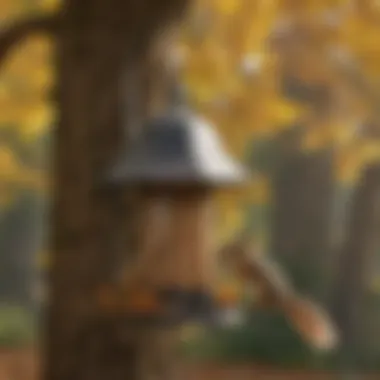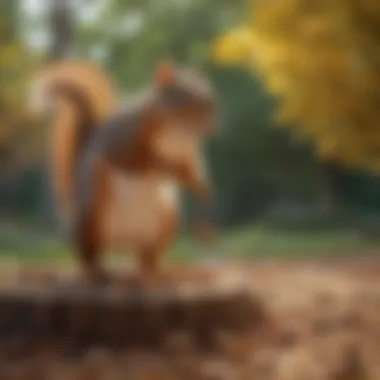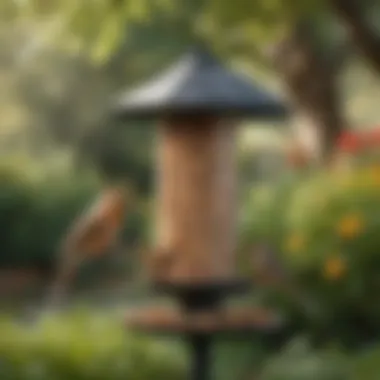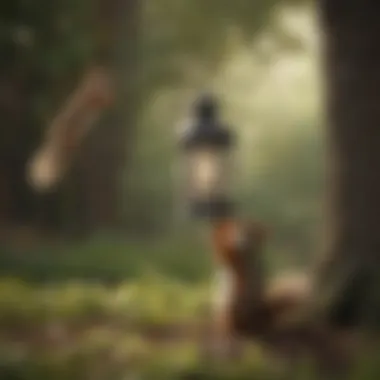Effective Strategies to Deter Squirrels from Bird Feeders


Intro
Squirrels can be charming residents of our gardens, frolicking about with an air of mischief. However, their antics do take a toll on backyard bird feeders. For garden enthusiasts eager to protect avian visitors, an understanding of effective strategies to thwart squirrel meddling is essential. These strategies not only secure feed for birds but also carefully balance the interaction between wildlife and our carefully cultivated habitats.
Given their acrobatic prowess and tenacious nature, squirrels possess an uncanny ability to scale poles and bypass barriers that may appear effective. This article assesses practical, long-term resolutions that engage both physical alterations and behavioral deterrence. Ultimately, it seeks to redefine how we think about creating spaces that nourish both birds and other wildlife common to our surroundings.
Through this discussion, various factors contributing to the squirrel issue will be unpicked, making way for comprehensible preventive measures for readers navigating similar challenges. In the dense world of avian nourishment, the harmony between man and nature serves as an ongoing challenge, one worth approaching through thorough examination and careful tactics.
The following sections will deliberate upon specific strategies, examining their effectiveness, ease of implementation, and versatility in contexts that also encompass sustainable living practices.
Understanding Squirrel Behavior
Understanding the behavior of squirrels is essential for anyone who wishes to protect bird feeders effectively. Squirrels, known for their adaptability and persistence, often pose a challenge for bird enthusiasts. This section leads into key insights about squirrel tendencies, motivations, and factors that come into play when they access food sources.
The Motivation Behind Squirrel Access
Squirrels are motivated by a strong instinct to find food. It is vital to understand that their primary goal is survival. In their quest to gather and store food, squirrels will navigate through various obstacles. They often consume seeds, nuts, and fruits, which are not just valuable for their nutrition, but also essential for their strategy of hoarding food for winter. Understanding this can help in identifying effective deterrence approaches.
Specifically, knowing that squirrels seek sustenance can give insight into the factors that attract them. It emphasizes that the choice of facilities for assisting the birds should be analyzed for their vulnerability in the presence of food-rich sources. This connection between their hunger and movement patterns marks an important aspect when developing physics barriers or deterrents.
Attraction to Bird Feeders
Bird feeders are typically filled with seed that is highly appealing to squirrels. To a squirrel, bird feed represents an easily accessible food source, and this is clear when feeders attract both birds and unwanted pests. Squirrel attraction intensifies when feeders are located near their natural habitats or accessible pathways.
Their curiosity and relentless energy can lead them also to investigate various impacts of the local environment. For instance, if your backyard has prevalent tree species like oaks or pines, these help them easily access feeders. Consequently, the dynamics of feeder setups can provide challenges that you must anticipate.
To mitigate this issue, one must reflect on distances, feeder visuals, and surrounding landscape. Recognizing these behavioral traits will subsequently guide installation decisions about feeder types and protective measures. This insight furnishes a groundwork before advancing to more practical strategies to reduce squirrel interference.
Assessing Your Bird Feeder Setup
Assessing your bird feeder setup is a crucial step in deterinh squirrels from accessing your bird feeders. Understanding how the placement, height, and type of feeder can influence squirrel behavior may seem straightforward. However, various elements intertwine to create conditions favorable or unfavorable for squirrels. Each aspect plays a critical role in determining the success of your strategy. An effective setup will not only hinder squirrels but also promote a harmoniously inviting environment for the birds.
Evaluating Feeder Height and Location
Feeder height and location greatly impact accessibility for squirrels. Ideally, feeders should be placed at a height exceeding five feet, making it challenging for squirrels to leap. Additionally, avoiding direct access points, like tree branches or fences, sets additional barriers.
When selecting a location, analyze the surroundings. Observing squirrels in your area often helps in making strategic decisions; avoiding placements within eight to ten feet of vertical supports lessens the risk of squirrel solicitation.
Factors to keep in mind include:
- Surrounding Vegetation: Dense shrubbery or climbing vegetation may facilitate access trends.
- Open Space: An area with plenty of distance between trees or structures makes it difficult for squirrels to navigate.
In both cases, consider using paired devices like designed squirrel-proof pole systems add-ons to increase odds of success greatly. Ensuring you conduct a brief evaluation based on these points will help uphold popular bird feeding while restricting negative behaviors from squirrels.
Types of Feeders and Their Vulnerabilities
Different feeder designs offer unique features and drawbacks. Understanding these irregularities may dictate modifications necessary to minimize squirrel intrusion. Recognizing which types of feeders are conducive or vulnerable begins the deterrence process.


Common feeder styles:
- Tube Feeders: These retain a cylindrical form, allowing seed dispersal from openings as birds feed. Due to their vertical orientation, squirrels typically face challenges haulting themselves here, however longer nipple openings pose risk at lower sites.
- Platform Feeders: These widely available designs encourage access from various angles and may lack physical barriers. This makes then particularly alluring for squirrels; design changes UID often directly influences vulnerabilities accordingly.
- Hopper Feeders: A distinct-shape feeder, often seen in gardens. These may pose unique attractants, susceptible to clever toucurs or drop off hunts when misconfigured—while optimized sizing alongside the platform can contribute significantly.
- Mesh Feeders: Wire mesh is another alternative present though thinning leaves poor infrastructure across windy sessions especially during high winds changes overall feeding convection resulting needless mishaps as that upset cycles feeding sprongs ineffeectively (this complexity will better alert uncertainties when spotting adhesions as observr poorly gel.
Realizing the compromises held + engaging with thoughtful assessments computes robust insights, generating active measures to limit squirrel approaches and distraction.* Knowing where vulnerabilities lie provides that cultivatal edge.+
Physical Barriers to Squirrel Access
Physical barriers play a crucial role in preventing squirrels from climbing bird feeder poles. These barriers can enhance the effectiveness of your feeding setup by creating physical obstacles that squirrels cannot easily navigate. By implementing robust structures, you can protect bird feeders and ensure that they remain accessible only to birds. Utilizing barriers is not only about securing the feeders; it also represents a commitment to maintaining the overall ecosystem balance.
Installing Baffles
Types of Baffles
Baffles are functional devices designed to obstruct squirrels from reaching feeders. Common types include dome-shaped and cone-shaped baffles, both offering a unique advantage—the ability to thwart climbing attempts effectively. Dome-shaped baffles typically have a larger diameter, providing a better shield against squirrels from above, while cone-shaped baffles angle away from the pole, making it hard for squirrels to climb upwards.
However, it's important to choose materials resistant to weather effects. Metal baffles could offer durability and longer service life but may affect aesthetic appeal.
Placement Guidelines
Placement is a key factor for baffles to work effectively. Both height and distance from the feeder are vital. Generally, a baffle should be positioned at least 5 to 6 feet above ground. Also, having a minimum of 12-18 inches between the top of baffles and the feeder helps to prevent squirrels from jumping to their target. By placing baffles securely, you ensure they remain stable, reducing the possibility of squirrels taking advantage of an insecure setup. Guarding against localized squirrel foot traffic is a task that requires mindful placement decisions.
Using Squirrel-Proof Feeders
Features of Squirrel-Proof Feeders
Squirrel-proof feeders incorporate distinct features aimed at blocking little thieves. Many have weight-sensitive mechanisms that close access upon sensing weight greater than that of a bird. Additionally, some models include metal designs with openings small enough to keep squirrels out while attracting smaller birds.
Such features exhibit effectiveness but might require occasional maintenance due to their mechanism sensitivity.
Recommended Brands
Several brands excel in producing squirrel-proof feeders. Look for options like Wildlife Research Center's Ultimate Squirrel Proof Bird Feeder and Droll Yankees' Yankee Flipper. These recommendations highlight brands committed to quality and effectiveness.popular choices for bird enthusiasts, showing long-lasting results in keeping squirrels at bay. Understanding different feeder designs and materials can assist in selecting the right brand. Each brand exhibits unique advantages in durability, ease of use, and cost-effectiveness, making careful assessment essential.
To establish a squirrel-free setup, understanding these physical barriers is fundamental. The combination of effective baffles and dedicated feeders aids in reducing squirrel motives and promoting a tranquil feeding environment for birds. It's critical to analyze and adapt multiple features to maximize your garden’s success in maintaining an exuberant bird habitat.
Behavioral Deterrents
Behavioral deterrents represent a crucial aspect when it comes to hinderig squirrels from accessing bird feeders. These methodologies focus on influencing the habits and patterns of these crafty creatures. By adopting behavioral techniques, bird enthusiasts can better safeguard their feeders and promote an appealing atmosphere for various bird species. The effectiveness of these strategies largely lies in their ability to confuse or divert squirrels from their primary target.
Altering Bird Feeder Feeding Times
Changing the feeding schedule of your bird feeders can serve as a simple but effective squirrel deterrent. If you feed birds at irregular times, it makes it harder for squirrels to build a routine. Thios unpredictability discourages them from lingering around.
Here are a few considerations to keep in mind:
- Electric change the filling hours so squirrels do not know when food will be available.
- Do not trough large amounts of feed during normally high squirrel activity periods, such as early mornings.
- Use feeders specifically designed with bungee cords or self-closing doors that limit access only during set times.
By keeping food availability erratic, you manage squirrel population's foraging behavior.


Creating a Distracting Environment
Another effective method to deter squirrels is to create an environment that diverts their attention away from your bird feeders. This added distraction can minimize their exploration onto the bird feeder poles. Here are some strategies:
- Planting: Consider planting dense vegetation away from feeders. This might include bushed or tall grasses. It attracts squirrels as alternative spots to explore.
- Feeding Stations: Establish additional feeding stations stocked with foods that squirrels enjoy, particularly items they can’t take from the bird feeders. Nuts and corn could be placed farther away. This lowers their need to venture to your primary feeders.
- Decoys: Placing squirrel-proof structures nearby can serve adhesion distraction if they engage with those unique outlets instead.
Creating diversions not only helps keep squirrels at bay but also illuminates birdseed enticing dialogue.
IMPORTANT: Implementing both feeding time alterations and designated distracting spots helps secure your feeding solutions while maintaining a lively wildlife experience. Employing these techniques can blend seamlessly with practical aspects discussed earlier.
Chemical and Taste Deterrents
Chemical and taste deterrents play a significant role in maintaining a squirrel-free atmosphere around bird feeders. They serve as an additional layer of protection without requiring structural modifications or drastic alterations to the environment. These deterrents can create a barrier that discourages squirrels from even approaching the feeders, while still accommodating the feeding of birds. They work largely on the principles of taste aversion and scent, offering both immediate and long-lasting effects.
Safe Repellants
When considering safe repellents, it is crucial to choose products that do not harm birds or other wildlife. Some common safe repellents include:
- Capsaicin: This natural compound, found in chili peppers, is an effective squirrel repellent. It affects the taste receptors of these animals, making birdseed unpalatable without impacting the birds, who are insensitive to capsaicin.
- Pepper Flakes: Sprinkling crushed red pepper flakes around the feeder area can act as a simple deterrent. The heat and burn from the flakes can discourage squirrels from ascending the feeder pole.
- Citrus Oils: Oils from citrus fruits, such as oranges and lemons, can be unpleasant for squirrels. Mixing these oils with water and spraying around the feeder may send squirrels packing.
Although these methods require reapplication after rain or heavy winds, their ease and safety make them effective choices for those looking to maintain harmony in their backyard habitat.
Efficacy and Limitations
While chemical deterrents can be valuable, it's crucial to understand both their efficacy and limitations. Efficacy can vary significantly depending on several factors:
- Persistence of Odors and Flavors: Some products may lose their effectiveness after exposure to moisture or become less potent over time. Consistency in application is necessary to keep deterrents effective.
- Squirrel Intelligence: Squirrels are adaptable creatures. Over time, they might begin to ignore certain deterrents or develop strategies to bypass them.
- Bird Behavior: Not all birds are equally sensitive to these deterrents, and some may stray away if the scent is too intense.
It’s essential to monitor squirrel activity after applying any repellents and adjust strategies accordingly. Before trying out any new methods, an initial period of observation can help inform the choice of deterrent.
In summary, chemical and taste deterrents can provide a robust noise against squirrels. However, these must be combined with other strategies found throughout this article for the highest chance of success.
Maintaining a Squirrel-Free Zone
Maintaining a squirrel-free zone around bird feeders is vital for achieving successful bird feeding. Squirrels can significantly interfere with your efforts to attract various bird species by consuming the bird seed and displacing these feathered visitors. A dedicated strategy focused on keeping this area clean and monitoring for squirrel activity can reduce the interference more effectively. The benefits also extend to creating a more enjoyable environment for the birds.
Regular Cleaning of the Area
Importance of Cleanliness
Cleanliness is central to the success of feeding birds and prevent squirrels from returning for a meal. A clean area reduces the smell and food sources that may attract squirrels. By removing leftover seeds, or unwanted debris, you lower the chances of an increased squirrel presence nearby. Through regular cleanliness, you promote better overall hygiene for any birds who visit because uneaten seeds may harbor pests or diseases. Such maintenance not only leads to a better immediate outcome but enhances the entire habitat.
Best Practices for Cleaning
Implementing best practices in cleaning can amplify the benefits discussed. The key characteristic of effective cleaning strategies is to ensure every corner around the feeders is regularly maintained. Start by removing old seeds and their shells weekly. After a windy day, re-check the cleanliness, as debris may scatter further apart. Another effective method is soaking and washing hanging feeders . This gets rid of any greasy residue and promotes a healthier feeding environment. Be cautious about any cleaning products used, as they should not not leave harmful residues behind.
Monitoring Squirrel Activity
Identifying Patterns


It's essential to understand the animal's behavior and identify patterns of their invading conduct. Observe the times of day they tend to appear and the specific methods they use to access the feeders. Knowledge of these patterns can provide insights into the best times for putting out bird feeders. A notable characteristic comes from knowing their routine can streamline feeding tcpion and ensure fewer disturbances.
Adjusting Strategies Accordingly
Being adaptive is paramount to the effectiveness of keeping squirrels away . Changing strategies based on observed squirrel patterns can make a significant difference. Whether it is varying feeder times or rotating types of bird seed, adjusting accordingly minimizes possible re-invasions. This reflects a responsive approach toward constant analysis of interactions between squirrels and birds. Such flexibility enables better protection against these persistent foes.
"Maintaining a clean feeding area and observing local squirrel activity provide more guarantee for the enjoyment of birdwatching."
Consistently adopting these practices forms a robust defense against squirrels. It assures will attract desired bird species while minimizing any leak into bird feeder productivity.
Evaluating the Effectiveness of Strategies
Evaluating the effectiveness of strategies to prevent squirrels from climbing bird feeder poles is vital. This analysis not only serves to confirm the success of the tactics used but also to identify areas needing improvement. Implementing solutions without checking their efficacy can lead to frustration and wasted resources.
Through proper evaluation, bird enthusiasts can create an optimal feeding environment that minimizes squirrel interference while attracting desired birds.
There are various dimensions to consider regarding this evaluation process.
- Why Measure Success: It is important to have specific benchmarks for success. Knowing what a successful outcome looks like helps in maintaining clarity.
- Adjusting Approaches: As conditions change over time, adjustments may be necessary. Birds and squirrels may alter their behavior based on seasons or food availability.
- Resource Allocation: Understanding efficacy allows for better allocation of time and resources.
Analyzing outcomes can lead to more innovative solutions that are tailored specifically to the unique challenges faced in one’s own backyard. Monitoring enables an enthusiastic approach towards bird-watching with better outcomes.
Setting Metrics for Success
Setting metrics for success involves defining clear and measurable objectives applicable to feeding stations. This process can greatly influence efforts in deterring squirrels. Key components of successful metrics may include:
- Amount of Bird Activity: Track the number of different bird species visiting the feeders. Successful strategies typically lead to an increase in visits.
- Reduction in Squirrel Damage: Measure how often squirrels are able to access food. A decrease here indicates that your plan is working.
- Duration of Feeding Time: Monitor how long the bird feeders remain accessible without squirrel disturbance. Longer periods mean effective deterrence in place.
Collecting this data can often require more than simple observation. Using recordings or keeping a journal to note behaviors and occurrences aids this evaluation. Analyzing patterns over time provides a clearer picture of what works best.
Making Adjustments Over Time
In a changing environment, making adjustment is crucial. Previous strategies might not always yield the same results after a certain period. An adaptable mindset will allow for fine-tuning the feeding setup.
One may need to assess the seasonal behaviors of both birds and squirrels, as they can vary. Squirrels might be more aggressive in late summer when they are preparing for winter and need to store food. Conversely, during the nesting season, birds may have different feeding needs as well. Some key points to consider include:
- Frequency of Reevaluation: Regularly check how successful the deterrents are, especially after season shifts. This can impact feeding habits significantly.
- Testing New Solutions: Do not hesitate to experiment with new barriers or feeders to discover if they perform better. An innovative approach will keep strategies fresh and effective.
- Adjusting Your Approach: Tailor approaches based on the most recent data collected. If one solution is failing, pivot to find what works better for your bird population.
Continuous competent evaluation allows bird lovers to stay ahead of squirrel interactions. By consistently reviewing strategies, a more inviting bird habitat can be established that balances a rich bird-viewing experience with minimized squirrel challenges.
Culmination and Recommendations
Using the strategies discussed in this article, you can successfully limit squirrel access to your bird feeders. It is essential to consider both the effectiveness of the measures taken and the upkeep of the surrounding area. Regular monitoring and data-driven adjustments will yield better results and ensure enduring success in keeping squirrels at bay. Evaluating the effectiveness of each method requires patience and flexibility in your approach. You might need to experiment with various solutions to find what works best in your specific environment.
Summary of Effective Techniques
To recap, here are the highlighted techniques that can be implemented to deter squirrels from climbing bird feeder poles:
- Installing Baffles: A physical barrier that prevents squirrels from climbing. This might include a dome or funnel designed specifically for this purpose. Ensure that the baffles are regularly checked for dirt and debris, as clean surfaces are more effective.
- Using Squirrel-Proof Feeders: Look for feeders specifically marked as squirrel-proof. Important features include weight-sensitive perches and enclosed feeding stations.
- Altering Feeding Times: Feeding birds during specific times of the day when squirrels are less active can help others enjoy their meals more peacefully.
- Creating Distractions: Provide squirrels with alternate food sources at a safe distance from your bird feeders. This can help limit their interest in your feeder.
- Applying Chemical Repellents: Deterrents that are safe for wildlife can also be an effective means. Test various options before settling on one.
Encouragement for Continued Exploration
Finally, it’s vital to keep an open mind and retain curiosity in your approaches. The most effective strategies will differ by region and local squirrel behaviors. Engage with local bird-watching clubs or communities, like those on Reddit or Facebook. Sources online can offer rich insight into what others find success with in similar environments.
Exploration and adapted methodologies are key. Document your results and share findings with others. Not only will this contribute to better techniques, but it can also help you connect with a community focused on both presenting effective deterrents while enhancing bird habitats.







